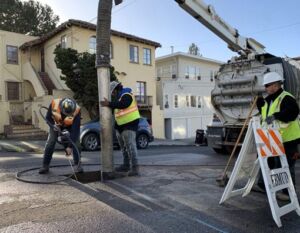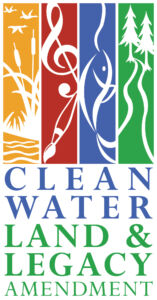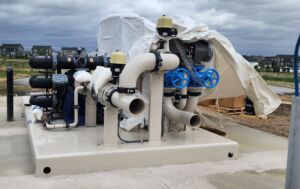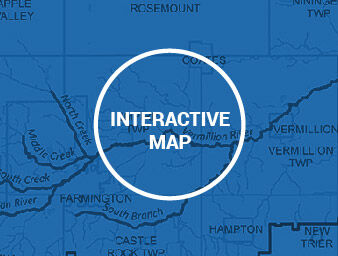Our Projects
VRWJPO invests in capital improvement projects that protect or improve water resources and/or are identified in the Watershed Plan. Projects are intended to address impairments such as phosphorus, total suspended solids (TSS), turbidity, nitrates, aquatic invasive species (AIS), and other issues as they arise.
The VRWJPO has received several grants to implement large-scale water resource projects funded through the Clean Water, Land, and Legacy Amendment approved by Minnesota voters in 2008. All completed capital improvement projects installed with VRWJPO funds are identified on an interactive map with yellow and red stars.
Current Projects
Grand Prairie Park Water Reuse and Recirculation
Background
Water reuse (also known as water recycling) is a tool used to combat the consequences seen with increased development in all land uses, fluctuations in precipitation and challenges communities face to meet long-term water needs. A stormwater harvest and reuse system is a constructed system that captures and retains stormwater for later use. The VRWJPO has partnered to implement several stormwater harvest and reuse systems over the past 15 years.
The City of Lakeville, partnering with the VRWJPO, is currently constructing Grand Prairie Park, which will feature five multi-use athletic fields and a full-sized baseball diamond. The park, located at the intersection of Cedar Ave and 185th Street, will introduce the City’s first splashpad.
In an effort to conserve local drinking water, the athletic fields will be irrigated via a stormwater harvest and reuse system. The park’s splash pad will utilize an underground recirculation tank for operation (pictured above). Potable water will be pumped into the system, undergoing treatment to ensure the recirculated water remains safe for recreational use.
Timeline
- Late summer 2025 – Splash pad scheduled to open to the public with water recirculation system
- Spring 2026 – Stormwater harvest and reuse irrigation system to begin operation
Benefits
- The stormwater harvest and reuse system is estimated to save 10 million gallons of drinking water per year.
- The splash pad water recirculation system is estimated to save 12 million gallons of drinking water per year.
Costs & Contributions
- VRWJPO: $300,000
- City of Lakeville: $678,160
Firelight Way Total Suspended Solids (TSS) Reduction
During the 2024 Watershed-Based Implementation Funding (WBIF) planning process, the VRWJPO, in partnership with the City of Lakeville, proposed installing a hydrodynamic separator (HDS) on Firelight Way east of Greenridge Park to reduce sediment transport in stormwater runoff from this area. Since the runoff flows to North Creek and eventually the Vermillion River, treatment can help address impairments in both water bodies. An HDS is a stormwater device that uses cyclonic forces to remove pollutants in stormwater runoff, namely sediment. After sediment settles to the bottom of the device, public works staff can remove it using a hydrovac truck (pictured below) for transport to the City’s disposal site.

Timeline (estimated)
- Spring/Summer of 2025: Complete subsurface soil studies, finish engineering design, and advertise for construction
- Late Summer/Fall 2025: Construction
- November 2025: Construction complete
Benefits
The project will result in an average annual removal of almost 1,900 lbs. of TSS per year from stormwater. The VRWJPO has installed these types of devices at multiple project sites in recent years, including several in Lakeville.
Costs & Contributions
- VRWJPO: $10,000
- City of Lakeville: $91,710
- Dakota County: $10,000
- Minnesota Board of Water & Soil Resources: $184,300 in Watershed-Based Implementation Funding
East Lake invasive carp & goldfish removal
East Lake, a shallow lake in Lakeville, is impaired for phosphorus, a problem exacerbated by invasive common carp and goldfish (rough fish, pictured below) digging for food in the phosphorus-bound lake bottom sediments. These fish species can make their way into the connected North Creek-Vermillion River and disrupt ecosystems there as well. Studies found that carp and goldfish biomass within East Lake had reached 192 lbs/acre. Research indicates negative water quality impacts associated with these bottom-feeding fish at biomass densities of 100 lbs/acre.
One way to address this problem is a barrier to keep these fish from moving into or out of the lake. VRWJPO, partnering with the City of Lakeville, received a competitive Clean Water Fund grant in 2023 to install a low-voltage electric fish barrier between East Lake and its connection with North Creek. The barrier began operating in spring 2024 and runs during non-winter seasons. This allowed VRWJPO and partners to remove these fish from the lake to populations acceptable for sustainable management purposes.
The first year (2024) of removals was quite successful, with 2,798 pounds of fish taken from the lake via electrofishing and baited box nets. Carp and goldfish biomass was reduced to 89.9 lbs/acre. But we can’t celebrate quite yet – goldfish are the predominant species in the lake, and while goldfish are a carp variant, there is no established biomass at which positive water quality impacts are known to be achieved. 2025 fish removals and water quality monitoring will run through the fall.
Benefits
The project is estimated to reduce total phosphorus in East Lake by 23 lbs./year and reduce invasive fish in North Creek and the Vermillion River.
Costs & Contributions
- VRWJPO: $5,000 for In-kind grant administration/coordination; estimated $37,500 cash match for construction of low voltage fish barrier and rough fish removals
- City of Lakeville: $37,500 cash match for construction of barrier and rough fish removals
- Dakota County: Operation and maintenance of barrier
- BWSR: $300,000 from competitive Clean Water Fund for engineering, technical assistance, and construction of barrier





